|
THIS IS A SIDE PAGE
RETURN TO MAIN KANNON PAGE
KANNON PHOTO TOUR
GODDESS OF MERCY, GOD OF COMPASSION
Comes in Many Forms to Help People in Distress in the Earthly Realm
Click any image to see larger photo.
Click any text link to learn more about that form of Kannon.
Most photos scanned from temple brochures and exhibition catalogs.
|
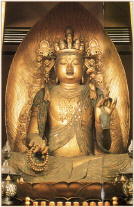
Juichimen Kannon
11-Headed Kannon (Wood)
10th to 12th Century
Rakuya-ji Temple
|
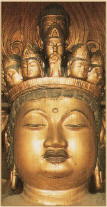
Juichimen Kannon
11-Headed Kannon (Wood)
10th to 12th Century
Rakuya-ji Temple
|
|
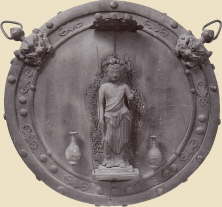
Juichimen Kannon
11-headed Kannon
1326 AD, Hase Dera
|
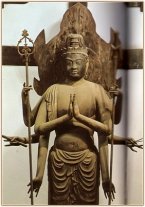
Fukukensaku Kannon
8th to 9th Century
Kouryu-ji Temple
|
|

Sho Kannon
10th to 11th Century
Tendai-ji Temple (Chuson-ji)
|

Yume-Chigai Kannon
8th Century
Horyu-ji Temple
|
|
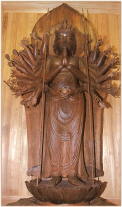
Senju Kannon
Heian Era
Fudarakusan-ji Temple
|

Sho Kannon
Heian Era
Ango-ji Temple
|
|
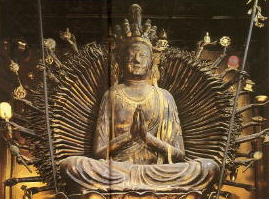
Senju Kannon (1000 Arms Kannon)
Fujii Dera, 752 AD
|
|

Senju Kannon
12th Century
Chuson-ji Temple
|
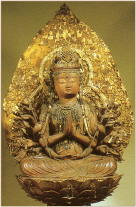
Senju Kannon
1154 AD
Bujyo-ji Temple
|
|
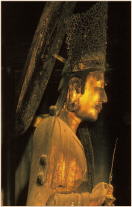
Kuse Kannon
7th Century
Horyu-ji Temple
|

Kuse Kannon
7th Century
Horyu-ji Temple
|
|
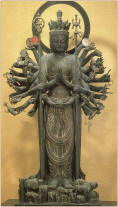
Senju Kannon
10th Century
Byodo-in Temple
|
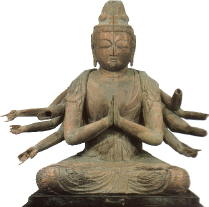
Senju Kannon
1012 AD
Kouryu-ji Temple
|
|
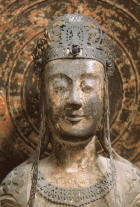
Kudari Kannon
7th Century
Horyu-ji Temple
|

Kudari Kannon
7th Century
Horyu-ji Temple
|
|

Sho Kannon
12th Century
Chuson-ji Temple
|

Juichimen Kannon (11 Headed)
Late Heian Era
Onsen-ji Temple
|
|

Juichimen Kannon (11-headed)
Late 8th Century
Kaniman-ji Temple
|
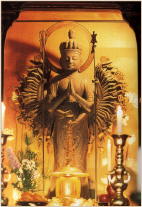
Senju Kannon
Late Heian Era
Onsen-ji Temple
|
|

Juichimen Kannon (11-headed)
Edo Era
Hase Dera
|
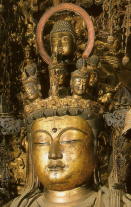
Senju Kannon (Closeup), 12th Century
Sanjusangendo (Kyoto)
Photo from temple catalog
|
|
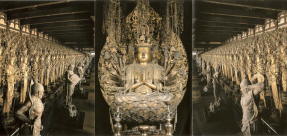
Senju Kannon (Middle Photo). 12th Century, Sanjusangendo in Kyoto.
Carved by Tankei (Unkei’s son). Photo scanned from temple catalog.
|
|
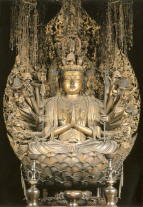 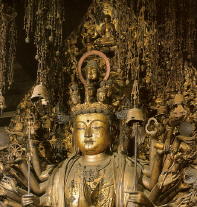
Senju Kannon, 12th Century, Sanjusangendo in Kyoto. Photo scanned from temple brochure
|
|
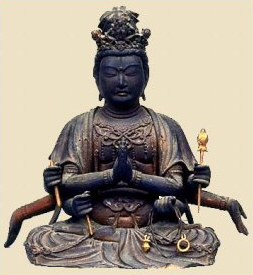
Fukukensaku Kannon - “Never Empty Lasso”
Lasso in hand to catch straying souls
and lead them to salvation; usually depicted with eight arms.
Sanskrit = Amoghapasa Avalokiteshvara
Kamakura Era, Wood
|
|
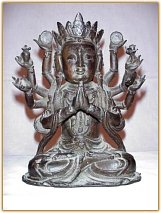
Quan Yin
Ming China (1368 - 1644)
Front of Statue
From Reader Scott Alexander
3-Faced Kannon
|
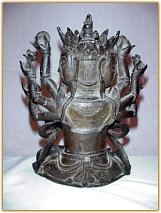
Quan Yin
Ming China (1368 - 1644)
Back of Statue
From Reader Scott Alexander
3-faced Kannon
|
|
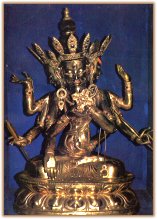
Multi-headed, multi-armed Kannon
Mongolia, 17th Century
Submitted by site visitor
|
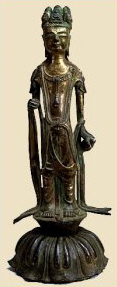
Juichimen Kannon
6th/7th Century, Horuyu-ji Temple
Submitted by site visitor
|
|
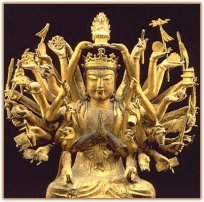
Senju Kannon
3rd Century Three Kingdoms Period
From Korea -- Chonsukwanunposal
|
|

This is a Side Page -- Kannon Bosatsu
Click here to return to Main Kannon Page
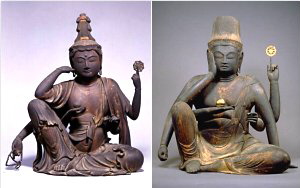
Nyo-irin Kannon
Courtesy Nara National Museum
(L) Kamakura Period (R) Heian Period, 10th century
http://www.narahaku.go.jp/meihin/ (Japanese language only)
A wonderful site with wonderful images of Buddhist art

Below Text Courtesy of
www.buddhanet.net/e-learning/history/b_fbodi.htm
Among the Bodhisattvas, it is Avalokitesvara who has the largest number of forms and is perhaps the most venerated and most popular Buddhist deity. His sex, originally masculine, is sometimes considered feminine in China and Japan, although this discrimination is unsupported by any canonical text. And was often considered in China and Japan as the 'mother of the human race' and, in this respect, worshipped in the form of a woman.
Avalokitesvara is known from very early in the development of the Mahayana doctrines and, until Buddhism disappeared from India, enjoyed great favour there. His cult passed from India to South-East Asia and Java, where it met with great success, and also in Nepal, Tibet (where he arrived with Buddhism and where King Srong-btsan Sgam-po, 519-650, was considered to be his incarnation), and in China, from where he went on to Korea and Japan. All these countries imagined him in different forms according to their own temperaments and spirituality.

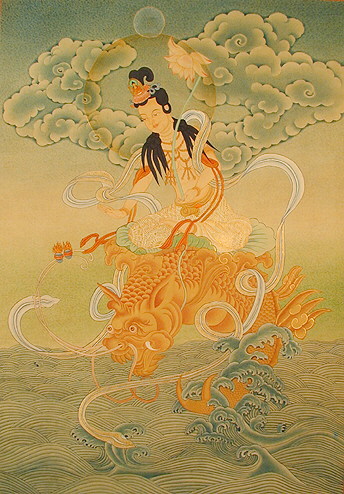
Kannon Bosatsu (Modern)
Unsure what she is riding.
Perhaps the Shachihoko (imaginary creature with the head
of a tiger and the body of a fish), or perhaps a Serpent/Dragon/Naga?
Photo courtesy www.tibetshop.com
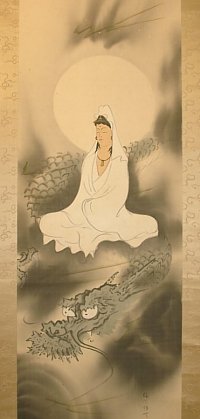
KANNON RIDING DRAGON SCROLL
By Baiun Sakamoto (1875-?). Baiun’s real name was Hisakichi.
Born in Nara Prefecture, lived in Osaka, apprenticed with Chikugai Himejima.
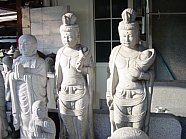
Modern Stone Statue
Koyasu (Child-Giving) Kannon (or perhaps Juntei Kannon) holding babe
Photo taken at Kamakura shop that sells stone statues, 2003
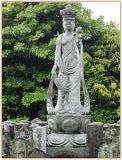 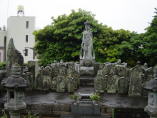 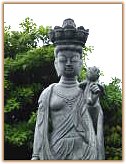
Juichimen Kannon (11-Headed Kannon) at Zenyo-in (Inatori City)
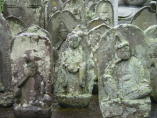 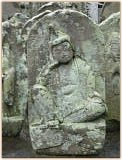 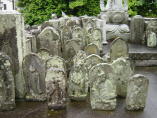
Stone statues surrounding the 11-headed Kannon
Center photo shows the Nyo-irin Kannon
Statues found at Zenyo-in (Inatori City)
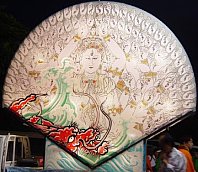
Festival artwork of the Senju Kannon (1000-arm Kannon)
Inatori Fertility Festival held in June each year (Dontsuku Festival)
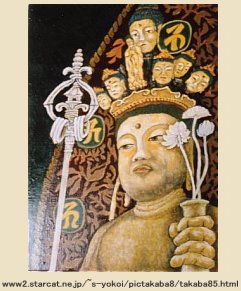
 
L: Ceramic Sho Kannon in collection of Robert Yellin
R: Sho Kannon at Hase Dera Temple, Kamakura, Japan

For Many More Wonderful Photos, Please Visit:
KANNON -- Shikoku, 88 Holy Sites, Kannon Photo Tour
Japanese Site. Wonderful photos of the Kannon statues found on this circuit. Photos courtesy of the Health Center Faculty of Medicine, Kagawa University. NOTE: Of the 88 temples in the Shikoku Pilgrimage, 29 are dedicated to Kannon. In addition, sacred pilgrimage images of the Kannon can be found by visiting this site’s Pilgrimage Guide.
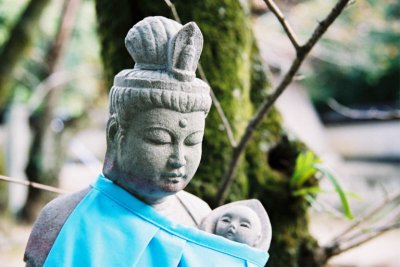
KOYASU KANNON
第71番:弥谷寺
88 Temples of Shikoku, Temple #71
kms.ac.jp/~hsc/henro/FJK/kannon/kannon.htm
See above site for many more photos.

This is a Side Page -- Kannon Bosatsu
Click here to return to Main Kannon Page
|